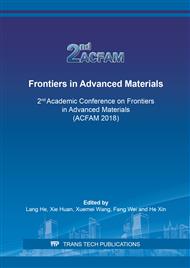p.181
p.192
p.201
p.212
p.218
p.229
p.237
p.244
p.253
Improving of Swellability and Water-Retention of Poly(Hydroxyethyl Methacrylate) by Introducing Cholesteric Liquid Crystal
Abstract:
Poly(hydroxyethyl methacrylate) liquid crystal gel was synthesized by chemical crosslinking. The structures and performance of the product were characterized by IR, TG, POM and SEM. The effect of the amount of liquid crystal on the properties of structure and swelling were conducted. The swelling behavior was investigated by crosslinking dosage, initiator dosage, neutralization and water retention. The results showed that the optimal preparation conditions of poly(hydroxyethyl methacrylate) liquid crystal gel was mCLC:mHEMA=2:1, mAPS/(mCLC:mHEMA) =1.5%, mMBA/(mCLC:mHEMA)=0.05%, neutralization=70% by orthogonal experiment. With the increasing of mCLC:mHEMA, the swelling property of liquid crystal gel firstly increased and then decreased. When mCLC:mHEMA=3, the swelling property reached the maximum value and the APS dosage was 2% of the total mass, and the liquid crystal gels had the highest swelling property up to 1024 g/g. When the MBA dosage was 0.05% of the total mass, the swelling performance of liquid crystal gel reached the maximum. The internal structure was relatively compact with forming the most folds on the outer surface, which could improve the free space on the surface and inside, and the liquid crystal gel formed 2~8 μm channel structure by introducing different crosslinking dosage. With the increasing of neutralization, the swelling property of liquid crystal gel firstly increased and then decreased. The neutralization was 90%, and the swelling property reached the maximum value. Liquid crystal gels were dried for 10 h at 60 °C, 70 °C, 80 °C, 90 °C and 100 °C, and the residual moisture contents were 70%, 65.44%, 55.8%, 47.2% and 34.63%, respectively. The materials had good water retention.
Info:
Periodical:
Pages:
218-228
Citation:
Online since:
June 2019
Authors:
Price:
Сopyright:
© 2019 Trans Tech Publications Ltd. All Rights Reserved
Share:
Citation:


